Creating an outdoor kitchen is an exciting venture that can enhance your home’s outdoor living space. Stone veneers offer a practical and aesthetic solution for achieving a stylish and functional design.
Their versatility allows for a range of styles, making them suitable for various tastes and preferences. Understanding how to effectively incorporate stone veneers into your outdoor kitchen will help you create a space that is both beautiful and functional.
In this guide, we will explore key tips for designing an outdoor kitchen with stone veneers, ensuring it meets your needs and enhances your home’s value.
Table of Contents
Why Choose Stone Veneers for Your Outdoor Kitchen?
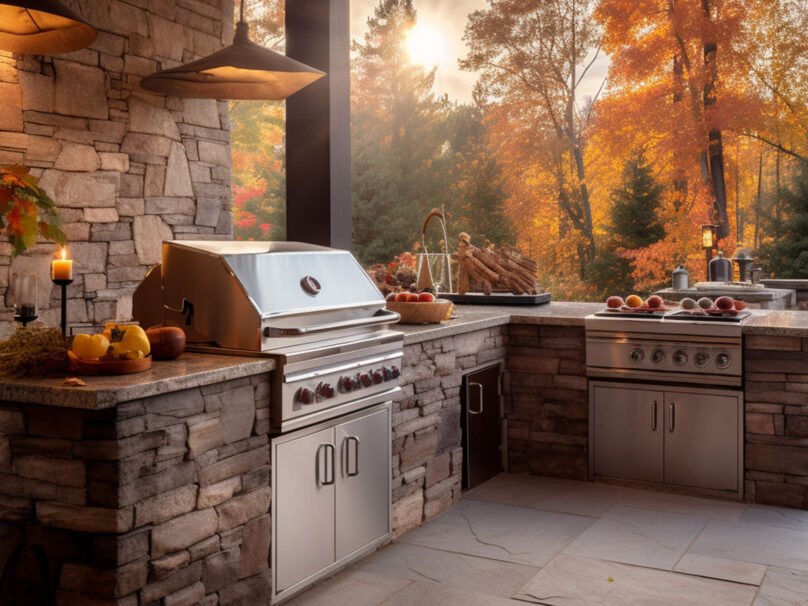
Stone veneers are a popular choice for outdoor kitchens due to their combination of durability, aesthetic appeal, and ease of installation. They provide the natural look of stone without the weight and expense associated with full stone construction. Here are some reasons to consider stone veneers for your outdoor kitchen:
- Aesthetic Variety: Stone veneers come in various colors, textures, and styles, allowing you to choose a look that complements your home and landscaping. Whether you prefer rustic, contemporary, or traditional aesthetics, there is a stone veneer to suit your design vision.
- Lightweight and Easy to Install: Unlike full stone, which can be heavy and challenging to work with, stone veneers are lightweight and can be installed over existing surfaces. This characteristic simplifies the installation process and can reduce overall costs.
- Durability: Stone veneers are designed to withstand the elements, making them a suitable choice for outdoor applications. They resist fading, chipping, and cracking, ensuring your outdoor kitchen maintains its beauty for years.
- Cost-Effective: Using stone veneers can be a more budget-friendly option than traditional stone. This cost-effectiveness allows homeowners to achieve the desired look without exceeding their budgets.
Types of Stone Veneers
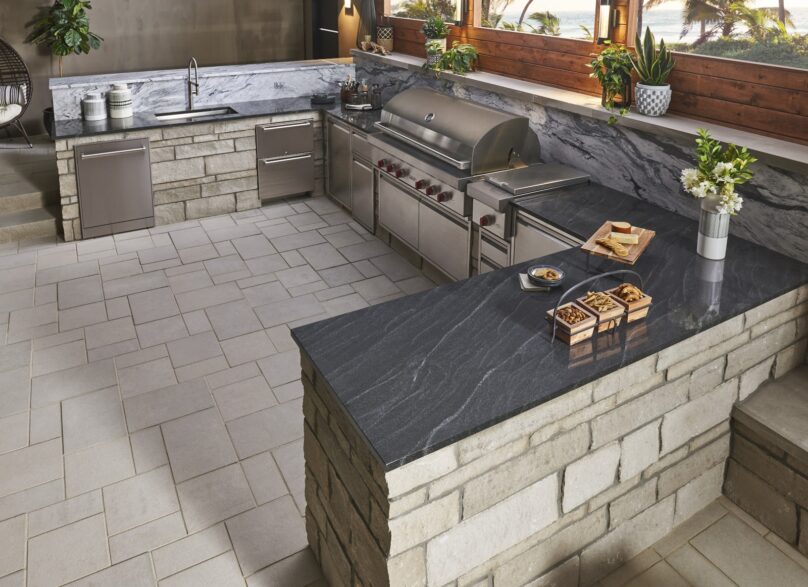
When considering stone veneers for your outdoor kitchen, it is essential to understand the different types available. Each type offers unique characteristics and advantages, helping you choose the best fit for your design and functional needs.
- Natural
Natural stone veneers are cut from real stone, providing an authentic appearance and texture. They are available in various types, such as granite, slate, and limestone, each offering distinct visual qualities.- Aesthetic Appeal: Natural stone veneers have unique color variations and textures, contributing to a visually striking design.
- Longevity: These veneers are highly durable and resistant to weathering, ensuring they last for years without significant wear.
- Manufactured
Manufactured stone veneers are crafted from concrete and aggregates, mimicking the appearance of natural stone. They are designed to offer a similar aesthetic at a lower cost and with easier installation.- Customization: Available in a wide range of colors and styles, manufactured stone veneers can be customized to fit various design themes.
- Lightweight: These veneers are lightweight, making them easy to transport and install, even for DIY projects.
- Brick Veneer As Alternative
Brick veneer provides a classic and timeless look that complements many outdoor kitchen designs. Available in various colors and styles, brick veneers can create a rustic or modern aesthetic, depending on your preference.- Versatility: Brick veneer can be used as an accent or as the main material for your outdoor kitchen, allowing for creative design possibilities.
- Low Maintenance: Similar to stone veneers, brick veneers require minimal maintenance and can withstand outdoor conditions without fading.
Planning Your Outdoor Kitchen Design
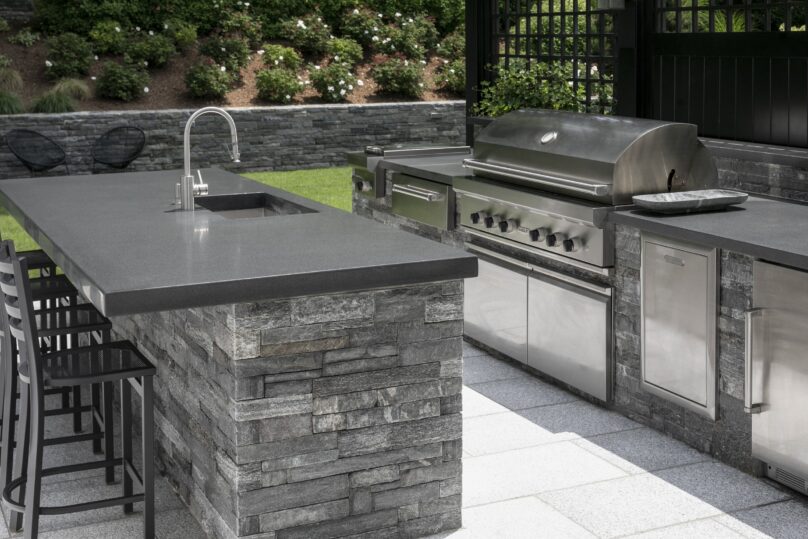
Creating an effective outdoor kitchen design involves careful planning to ensure the space is both stylish and functional. Here are some key considerations to guide your design process:
- Define Your Cooking Needs
Assess how you plan to use your outdoor kitchen. Consider the types of meals you enjoy preparing and whether you need additional features such as a grill, oven, or side burners. Understanding your cooking needs will help you design a space that accommodates your culinary activities.- Layout Considerations: Determine the best layout for your outdoor kitchen based on your cooking style. A U-shaped or L-shaped design can provide ample workspace and efficient traffic flow.
- Choose Your Style
Selecting the right style is crucial for achieving the desired aesthetic. Consider your home’s architectural style and the surrounding landscape when making your choice. Mixing different stone and brick veneers can create visual interest while maintaining cohesion in your design.- Color Coordination: Ensure that the colors of your stone veneer complement your home’s exterior and outdoor furnishings. Harmonizing colors creates a unified look that enhances your outdoor space.
- Incorporate Functional Features
Think about incorporating functional features that enhance usability. Options such as countertops, storage cabinets, and sink areas can significantly improve the functionality of your outdoor kitchen.- Countertop Materials: Select countertop materials that withstand outdoor elements and are easy to clean. Stone, granite, or concrete countertops can provide durability and style.
- Plan for Seating and Dining Areas
Consider how you will use the outdoor kitchen for entertaining and dining. Incorporate seating areas that allow family and guests to enjoy meals outdoors.- Seating Arrangements: Bar stools or built-in benches can create inviting spaces for gatherings. Ensure that seating is positioned for easy access to the cooking area.
- Lighting and Electrical Considerations
Good lighting is essential for outdoor kitchens, especially for evening use. Incorporate task lighting over cooking areas and ambient lighting for seating and dining spaces.- Electrical Planning: If you plan to use appliances, ensure you have the necessary electrical connections. Consulting a professional for installation can help prevent potential issues.
Installation Tips
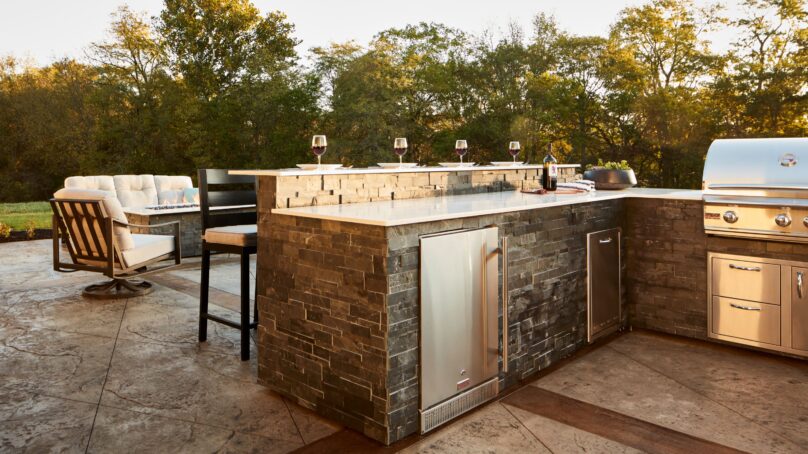
Successfully installing stone veneers in your outdoor kitchen requires careful attention to detail. Here are essential installation tips to ensure a smooth process:
- Prepare the Surface
Ensure that the surface where you will apply the stone veneers is clean, dry, and free of debris. Any existing materials, such as old siding or paint, should be removed or properly prepared to create a stable base for the veneers.- Choosing Adhesives: Select the appropriate adhesive for your stone veneer. Manufacturers often provide guidelines for the best types of adhesives to use based on the veneer material.
- Plan Your Layout
Before installing the veneers, plan your layout by arranging the stones in a dry fit. This step allows you to visualize the final appearance and make any necessary adjustments.- Mixing Colors: If using multiple colors or styles, mix them during the layout to ensure an even distribution and visually appealing result.
- Use a Level
As you install the veneers, use a level to ensure that each piece is installed straight and even. Maintaining a consistent alignment helps achieve a professional finish.- Trowel Techniques: Use the appropriate trowel for applying adhesive. A notched trowel can help create a better bond between the stone and the surface.
- Grouting and Sealing
After the veneers are installed, consider grouting between the stones for added stability and aesthetic appeal. Use a grout that complements your choice and seals the installation against moisture.- Sealing for Protection: Once the grout has cured, apply a sealant to protect the stone veneers from water damage and staining, especially in outdoor conditions.
- Finishing Touches
Add any finishing touches, such as trim pieces or decorative accents, to enhance the overall look of your outdoor kitchen. These details can elevate the design and create a polished appearance.
Maintenance
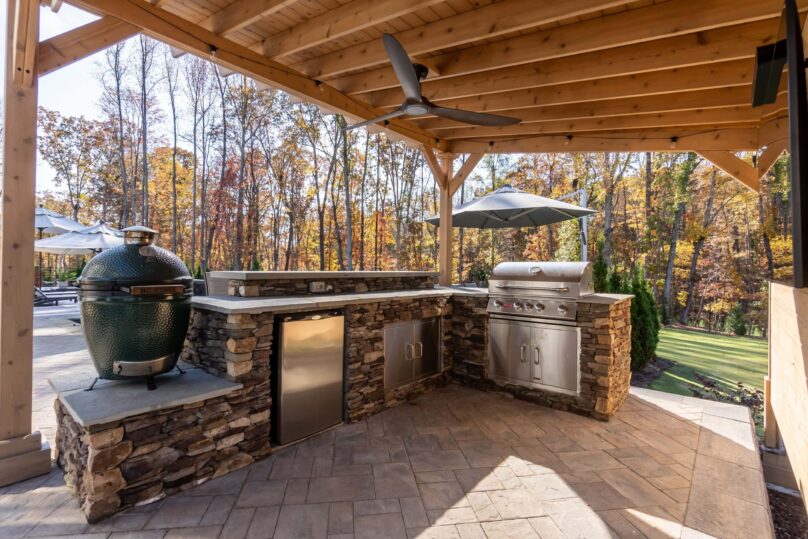
Proper maintenance of stone veneers ensures their longevity and keeps your outdoor kitchen looking pristine. Here are some maintenance tips to consider:
- Regular Cleaning
Clean your veneers regularly to prevent dirt and grime buildup. Use a soft brush or cloth to wipe down the surfaces, avoiding harsh chemicals that could damage the stone.- Gentle Cleaning Solutions: A mixture of mild soap and water can effectively clean surfaces without causing harm.
- Inspect for Damage
Periodically inspect the veneers for any signs of damage, such as cracks or loose stones. Early detection allows for prompt repairs and prevents more significant issues from developing.- Addressing Repairs: If you notice any loose stones, reattach them with the appropriate adhesive. For cracks, use a filler that matches the color to maintain a uniform appearance.
- Sealing
Depending on the type of stone veneer, resealing may be necessary to protect against moisture and stains. Follow the manufacturer’s recommendations for sealing frequency and products.- Sealant Application: Ensure that the sealant is evenly applied and allowed to cure according to instructions to provide the best protection.
- Avoid Harsh Conditions
Protect your outdoor kitchen from extreme weather conditions whenever possible. Consider using protective covers for furniture and appliances during harsh weather or when not in use.- Winter Preparation: In colder climates, drain and store outdoor appliances during winter months to prevent damage from freezing temperatures.
- Regular Maintenance Checks
Establish a routine for maintaining your outdoor kitchen, including cleaning, inspections, and repairs. Regular upkeep will prolong the life of your veneers and enhance the overall appearance of your outdoor space.
Conclusion
Designing an outdoor kitchen with stone veneers offers a perfect blend of style and functionality. Their versatility and aesthetic appeal make them an excellent choice for enhancing your outdoor space. By understanding the various types of stone veneers, planning your design thoughtfully, and following installation and maintenance tips, you can create an outdoor kitchen that meets your cooking and entertaining needs.
Related Posts:
- Glamping in Norway: Tips for a Luxurious Outdoor Adventure
- Which Deck is Easiest to Build: Choosing the Right…
- At What Stage Is Relationships the Hardest? Insights…
- How Can I Find Out the History of a Car? Essential…
- What is Extra Virgin Olive Oil? Essential Facts and…
- 10 Tips for Buying Safe and Reliable Used Tires













